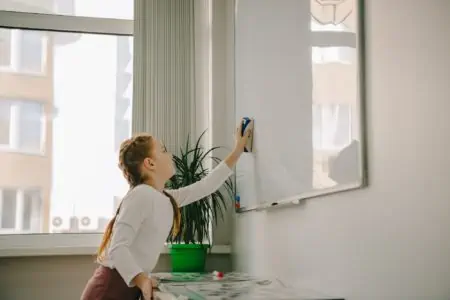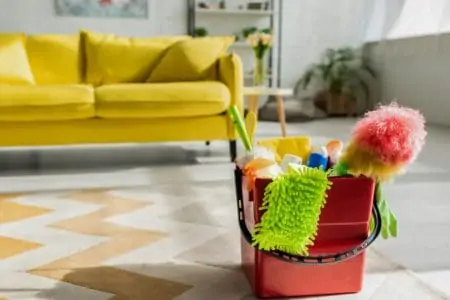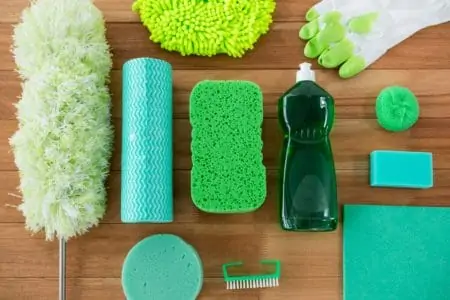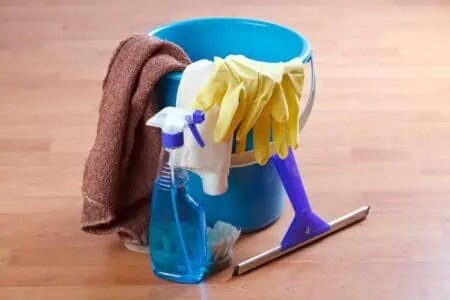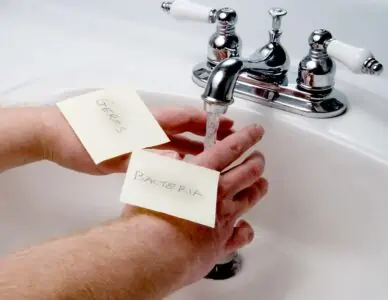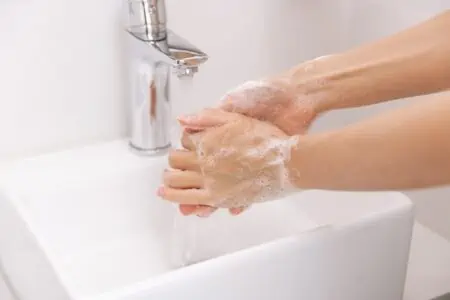Whiteboards are very handy items — you can use them at work, at home, in the classroom, and much more. However, if you don’t clean it properly, you can end up with stains and streaks.
We’ll show you how to clean a whiteboard with an old marker on it, as well as how to clean whiteboards after each use.
We’ll also share whiteboard cleaning hacks and warnings. Everything you want to know about a whiteboard — we’ll answer right here, right now.
Key Takeaways
- Clean whiteboards regularly to prevent stains and ghosting, using a whiteboard cleaner, a dry cloth, a damp cloth, and a final dry cloth.
- For dried stains, go over them with a fresh dry erase marker before erasing, and if needed, use a whiteboard cleaner.
- Avoid using permanent markers, high-toxicity cleaners, wax-based cleaners, abrasive cleaners, chalkboard erasers, and paper towels on whiteboards.
- Some cleaning hacks for whiteboards include rubbing alcohol, vinegar, WD-40, Windex, detergent, Magic Eraser, nail-polish remover, toothpaste, hairspray, and microfiber cloths.
Types of Whiteboards
There are three main types of whiteboards. Depending on what kind you have, it changes your cleaning approach slightly, so it’s important to know what you’re dealing with.
Melamine
Most whiteboards are made from melamine: a type of plastic backed by a pressboard. The best cleaning tip we can give you with this type is to clean it immediately after you use it to avoid staining and ghosting.
Melamine is slightly porous, so it tends to cling to ink. If you accidentally use permanent markers on melamine whiteboards, you could end up with a stain that’s impossible to remove.
Porcelain
Porcelain whiteboards are made from ceramic and backed by steel. These durable whiteboards are more expensive but also more resistant to staining and ghosting. The ceramic isn’t porous, which makes porcelain easier to clean. You can use fresh dry-erase markers to remove stains or general cleaning solutions to remove ink.
If you’re going to be using a whiteboard daily, then porcelain is your best bet.
Tempered Glass
Last but not least, we have tempered glass. This is the most expensive type of whiteboard. The good news is that glass is non-porous so these whiteboards won’t stain or ghost. So you don’t need to clean it as often. It’s okay if you leave ink on it all week. We recommend weekly cleaning — using a mild detergent or a glass cleaner.
How to Clean a Whiteboard That Won’t Erase
When you take your whiteboard eraser to the whiteboard and find that the ink has dried on, what can be done? We’ll show you how to clean marker stains off of a whiteboard in the easiest but most effective way.
- Time: 10 minutes
- Difficulty: Easy
What You’ll Need
- Fresh dry eraser marker
- Whiteboard eraser
- Whiteboard cleaner (such as Expo)
- Cloth
- Cold water
1. Go Over Stains With Fresh Marker
This is an incredible hack that we’ve used for years! If you have dried marker stains, simply go over them with a fresh dry eraser marker. Leave it for a few minutes to dry.
2. Erase Stains
Use your whiteboard eraser to rub out the stains. They should just come right off with the fresh marker, too. If not, repeat steps one and two a couple more times until the whiteboard is clean.
3. Spray With Cleaner
If there are still some stains or ink residue, spray them with a whiteboard cleaner. Expo is a trusted cleaner that’s been around for decades!
4. Wipe
Dampen a cloth in cold water and rub off the cleaning solution. It should lift off loosened stains, leaving you with a clean whiteboard.
How to Clean a Whiteboard After Each Use
If you use your whiteboard frequently, it’s a good idea to clean it properly after each use. This minimizes stains and ghosting. For this, you can use a whiteboard cleaner, such as Expo. But we’ll also show you how to make a DIY whiteboard cleaner.
- Time: 15 minutes
- Difficulty: Easy
What You’ll Need
- Whiteboard cleaner (such as Expo) OR
- Homemade whiteboard cleaner (spray bottle, water, rubbing alcohol)
- Whiteboard eraser
- Three cloths
- Water
1. Erase
Start by simply going over the ink with a whiteboard eraser. This is often enough to remove all the ink, especially if it’s not been on the whiteboard for too long.
2. Gather Solution
If you’re using a commercial whiteboard cleaner, simply grab it.
If you want to clean without a commercial whiteboard cleaner, make your own solution. Mix a 1:1 ratio of water and rubbing alcohol in a spray bottle. Shake to mix well.
3. Spray Whiteboard
Mist your whiteboard cleaner over your whiteboard. Don’t oversaturate it — a light layer is just fine.
4. Wipe, Then Wipe Again
Wipe the whiteboard with a dry cloth, removing stains and spray residue.
Dampen a separate cloth in cold water and wipe the whiteboard again to remove any cleaning residue.
5. Dry
Wipe the whiteboard dry with a separate dry cloth. Leave to air dry.
Whiteboard Cleaning Hacks
While the above methods should be all you need to maintain and clean your whiteboard, some other hacks can come in handy. You might already have these items in the house, making it easy to take to the whiteboard. Or you might want to try something else for stubborn stains.
With Rubbing Alcohol
As mentioned, dilute rubbing alcohol with water using a 1:1 ratio. Pour into a spray bottle, shake well, and spritz over the whiteboard before wiping with a dry cloth.
With Vinegar
Mix a 1:1 solution of distilled white vinegar and water into a spray bottle. Apply to the whiteboard. Leave for a few minutes before wiping with a dry cloth.
With WD-40
Spray WD-40 directly onto your whiteboard before wiping off with a clean, dry cloth. Be careful when applying it — you don’t want to get any on your skin or your clothes. It can cause irritation and stain garments.
With Windex
If you have a tempered glass whiteboard, try cleaning the whiteboard with Windex. Spray a little onto a dry microfiber cloth and gently clean the whiteboard until stains have lifted.
With Detergent
Dish detergent, such as Dawn soap, is excellent for cleaning whiteboards, especially tempered glass. Dampen a cloth with water, then add a drop of dish soap. Rub into the whiteboard, applying more elbow grease on stained areas.
With Magic Eraser
Dampen a Magic Eraser with water. Use as you would a regular whiteboard eraser, going over the ink to remove it.
With Nail-Polish Remover
An acetone-based nail-polish remover is effective at removing ink stains from whiteboards. Dampen a cloth with cold water and add a small amount of nail polish remover to the cloth. Rub over the ink to remove stains.
With Toothpaste
Apply toothpaste directly to the stained areas of the whiteboard. Wipe away with a soft, damp cloth.
Warning
Toothpaste can be slightly abrasive, so it might damage your whiteboard’s surface. Only use this as a last resort.
With Hairspray
Hairspray typically is made with alcohol, so it’s a great option for removing stains. Spray the whiteboard with hairspray and leave it for a couple of minutes. Dampen a cloth with warm soapy water and wash the whiteboard. To remove sticky hairspray residue, you must use soapy water for this final step.
With a Microfiber Cloth
Sometimes a microfiber cloth is all you need for cleaning a whiteboard, especially for daily cleaning. Dampen the cloth with cold water and wipe your board. Use a separate dry cloth to dry the board.
What Not to Use on a Whiteboard
While there are many things you can use on your whiteboard, here are some things you should avoid:
- High-toxicity cleaners: Use mild cleaners only. Don’t use standard kitchen and bathroom cleaners, bleach, or industrial cleaners.
- Wax-based cleaners: If a cleaner has wax, it will leave behind a filmy residue on the whiteboard.
- Abrasive cleaners: Notice how we never mentioned baking soda? Abrasive cleaners will scratch the whiteboard’s surface.
- Your hands: It might be tempting to rub some ink off with your hands, but your skin’s oils can build up on the whiteboard.
- Chalkboard eraser: This will not remove the ink sufficiently.
- Permanent markers: They will be hard to remove and could leave permanent stains.
- Paper towels: Paper towels and toilet rolls can disintegrate and leave behind residue and fluff. Instead, use soft cloths, preferably lint-free ones like microfiber.
How to Recondition a Whiteboard
If your whiteboard has been used so much to the point where it essentially feels useless, don’t throw it away just yet. You can restore it temporarily using this method. It’ll see you by until you can get a new whiteboard.
- Time: One hour (plus waiting time)
- Difficulty: Intermediate
What You’ll Need
- Whiteboard eraser
- Cloths
- Whiteboard cleaner (store-bought or DIY)
- Carnauba-based wax (such as Chemical Guys WAC21516 Banana Spray)
- Terry cloth towel
1. Erase
Start by erasing the board with your whiteboard eraser. Even if nothing comes off, this is a good step to remove surface-level debris.
2. Clean the Board
Using our “How to Clean a Whiteboard That Won’t Erase” steps, clean your whiteboard. Remember, you can use store-bought cleaners or your own recipe.
3. Apply Wax
Once the board is dry, apply a little carnauba-based wax to a cloth. Rub that onto the whiteboard to create a generous layer across the entire board. Leave it to dry for a few days. Don’t panic if it turns yellow — that’s normal.
4. Rub Off Wax
Use your terry cloth towel to rub off excess dry wax. This might take a while, as well as some effort, but keep going until the whiteboard is even and buffed. The board should be smooth, with no yellow residue left.
This procedure will resurface and recondition your whiteboard, allowing you to use it again. It might not last forever, but it’s a great fix. This might give you another few weeks of use, but some folks tried this and got a few more years. So we think it’s worth a go.
How to Clean a Whiteboard Eraser
You use the whiteboard eraser pretty much every day, so it’s important to keep it clean. Here’s how:
- Brush: Use a soft-bristled brush to brush the surface of the eraser. Move back and forth, starting from the top to the bottom. Repeat to remove as much loose debris as possible.
- Make solution: In a bowl, mix dish soap and water.
- Clean the eraser: Dip the eraser into the solution and scrub the eraser felt in circular motions from top to bottom.
- Rinse: Rinse the eraser with cold water.
- Dry: Blot the eraser with thick towels to remove as much excess water as possible. Then let the eraser fully air dry.
FAQs
Whiteboard Wrap Up
When you buy a whiteboard, you want it to last. Regular cleaning and maintenance can absolutely help with that. The best way to clean a whiteboard daily is by erasing your ink, spraying your board with a cleaner, wiping with a dry cloth, followed by a wet cloth, followed by another dry cloth.
When you have set-in stains, try going over them with a fresh dry erase marker before erasing.
You can also try fun hacks, like Windex, acetone, or even hairspray! Remember to never use high-toxicity cleaners, abrasive cleaners, or your hands to clean your whiteboard.
Now that you know how to clean a dry erase board, yours will last much longer and perform better.
